
The National Preparedness Report provides all levels of government, the private and nonprofit sectors, and the public with practical insights into preparedness to support decisions about program priorities, resource allocations, and community actions. The 2016 National Preparedness Report identifies cross-cutting findings that evaluate core capability performance, key findings in the Prevention, Protection, Mitigation, Response, and Recovery mission areas, and notable examples of preparedness progress over the past five years.
What is the National Preparedness Report?
The National Preparedness Report evaluates and measures gains individuals and communities, private and nonprofit sectors, faith-based organizations, and all levels of governments have made in preparedness and identifies where challenges remain. The 2016 National Preparedness Report focuses primarily on preparedness activities undertaken or reported during 2015 and summarizes progress in building, sustaining, and delivering the 32 core capabilities outlined in the National Preparedness Goal.
The 2016 National Preparedness Report reflects the input of more than 450 data sources and 190 stakeholders, including 66 non-Federal organizations.
| Federal Data Call Submissions | Federal Offices Engaged | Data Sources Referenced | Threat and Hazard Identification and Risk Assessments | State Preparedness Report Submissions |
| 116 | 124 | 450+ | 125 | 56 |
Introduction
A secure and resilient Nation with the capabilities required across the whole community to prevent, protect against, mitigate, respond to, and recover from the threats and hazards that pose the greatest risk.
| Core Capability | Prevention | Protection | Mitigation | Response | Recovery |
| Planning | ♦ | ♦ | ♦ | ♦ | ♦ |
| Public Information and Warning | ♦ | ♦ | ♦ | ♦ | ♦ |
| Operational Coordination | ♦ | ♦ | ♦ | ♦ | ♦ |
| Intelligence and Information Sharing | ♦ | ♦ | |||
| Interdiction and Disruption | ♦ | ♦ | |||
| Screening, Search, and Detection | ♦ | ♦ | |||
| Forensics and Attribution | ♦ | ||||
| Access Control and Identity Verification | ♦ | ||||
| Cybersecurity | ♦ | ||||
| Physical Protective Measures | ♦ | ||||
| Risk Management for Protection Programs and Activities | ♦ | ||||
| Supply Chain Integrity and Security | ♦ | ||||
| Community Resilience | ♦ | ||||
| Long-term Vulnerability Reduction | ♦ | ||||
| Risk and Disaster Resilience Assessment | ♦ | ||||
| Threat and Hazard Identification | ♦ | ||||
| Critical Transportation | ♦ | ||||
| Environmental Response/Health and Safety | ♦ | ||||
| Fatality Management Services | ♦ | ||||
| Fire Management and Suppression | ♦ | ||||
| Logistics and Supply Chain Management | ♦ | ||||
| Mass Care Services | ♦ | ||||
| Mass Search and Rescue Operations | ♦ | ||||
| On-scene Security, Protection, and Law Enforcement | ♦ | ||||
| Operational Communications | ♦ | ||||
| Public Health, Healthcare, and Emergency Medical Services | ♦ | ||||
| Situational Assessment | ♦ | ||||
| Infrastructure Systems | ♦ | ♦ | |||
| Economic Recovery | ♦ | ||||
| Health and Social Services | ♦ | ||||
| Housing | ♦ | ||||
| Natural and Cultural Resources | ♦ |
2015 Year in Review

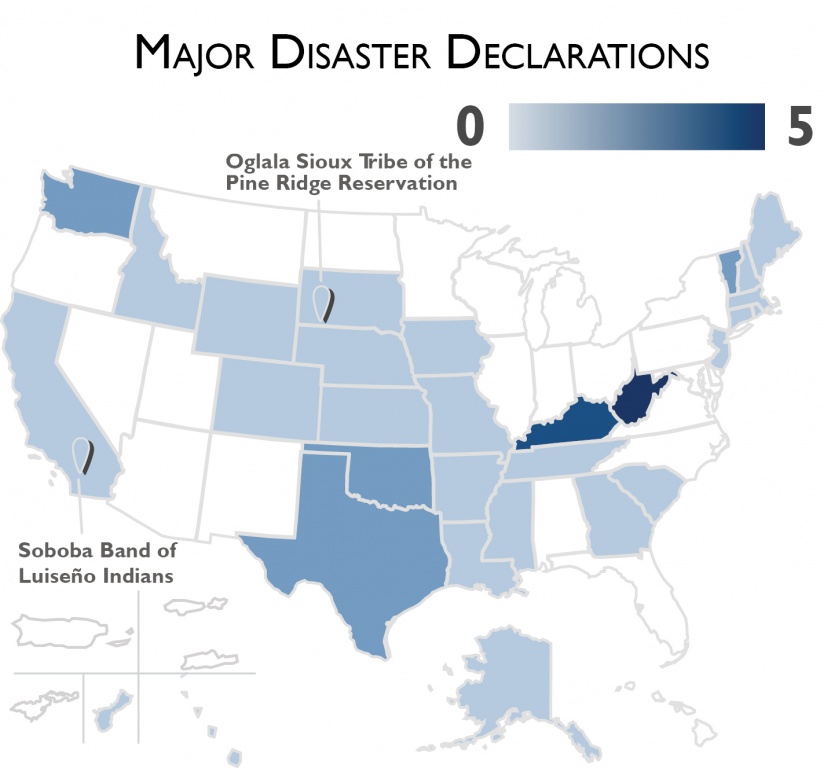
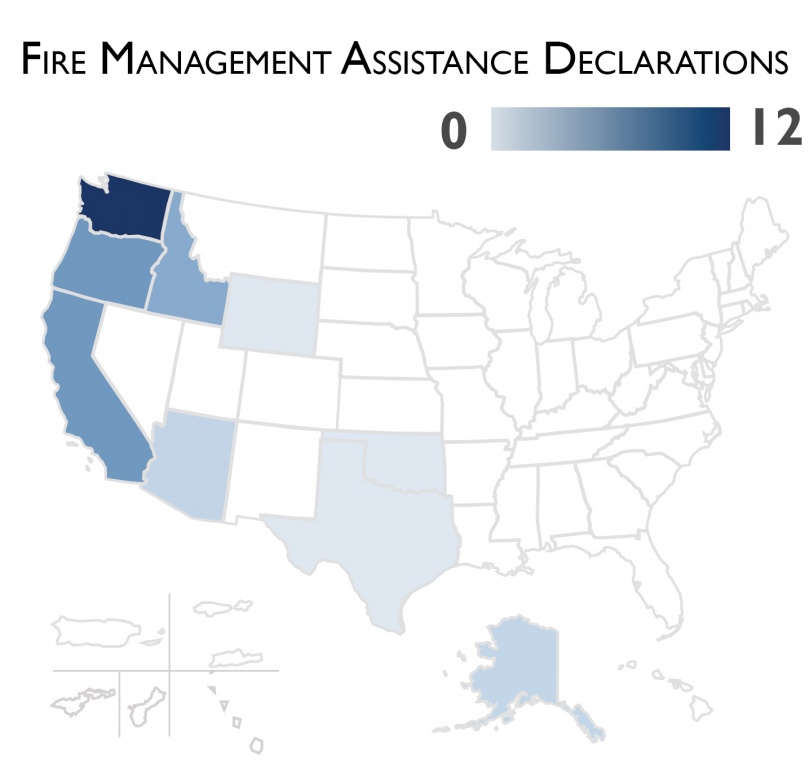
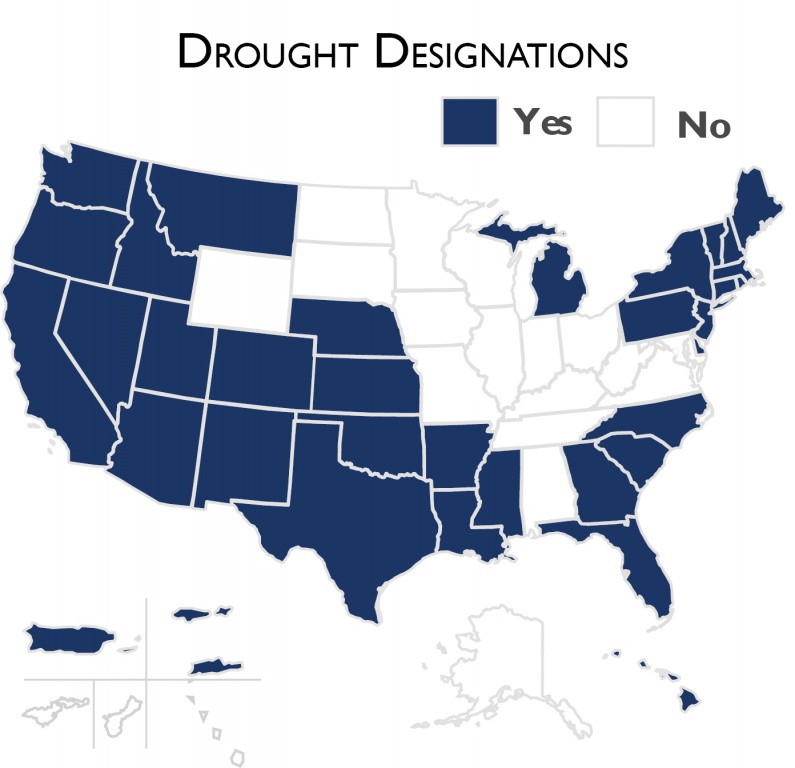

Cross-cutting Findings
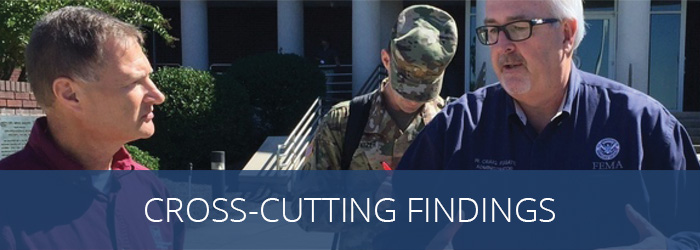
The National Preparedness Report identifies three cross-cutting findings by evaluating current core capability performance (e.g., assessments, exercises) and indicators of future capability demand.
Planning; Public Health, Healthcare, and Emergency Medical Services; and Risk and Disaster Resilience Assessment are three core capabilities in which the Nation has developed acceptable levels of performance for critical tasks, but that face performance declines if not maintained and updated to address emerging challenges.
Cybersecurity, Economic Recovery, Housing, and Infrastructure Systems remain national areas for improvement. Two additional core capabilities—Natural and Cultural Resources, and Supply Chain Integrity and Security—emerged as new national areas for improvement.
States and territories continue to be more prepared to achieve their targets for Response core capabilities, while they are least prepared to meet their targets in the Recovery mission area.
The 2012 - 2016 National Preparedness Reports identified select core capabilities as national areas for improvement.
| Core Capabilities | 2013 | 2013 | 2014 | 2015 | 2016 |
| Access Control and Identity Verification | ♦ | ||||
| Cybersecurity | ♦ | ♦ | ♦ | ♦ | ♦ |
| Economic Recovery | ♦ | ♦ | ♦ | ♦ | |
| Health and Human Services | ♦ | ♦ | ♦ | ||
| Housing | ♦ | ♦ | ♦ | ♦ | ♦ |
| Infrastructure Systems | ♦ | ♦ | ♦ | ♦ | ♦ |
| Long-term Vulnerability Reduction | ♦ | ♦ | |||
| Natural and Cultural Resources | ♦ | ♦ | ♦ | ||
| Supply Chain Integrity and Security | ♦ |
Prevention

The Prevention mission area focuses on ensuring the Nation is optimally prepared to avoid, prevent, or stop an imminent terrorist attack within the United States.
- In 2015, the National Network of Fusion Centers continued to enhance its intelligence-collection and information-sharing capabilities, enabling fusion centers to better integrate resources to prevent potential threats of terrorism.
- The terrorist attack in San Bernardino, California, highlights challenges in detecting and preventing attacks from self-radicalized individuals who are inspired by foreign terrorist organizations, even as Federal, state, and local agencies have taken steps to strengthen the Nation’s ability to address such attacks.
- The Federal Government continued efforts to enhance the Nation’s capabilities to prevent radiological, nuclear, and explosives incidents.
- Nationwide, federally supported exercise and training programs continue to strengthen law enforcement’s capacity to detect and prevent imminent threats that may exist at large-scale public events.
- Use of small unmanned aircraft systems presents novel challenges to security, creating an avenue for terrorists to threaten airspace and physical infrastructure.

National Network of Fusion Centers: The 2012 National Preparedness Report highlighted the U.S. Department of Homeland Security (DHS) efforts—through training, technical assistance, and deployment of personnel—to enhance the capabilities of the National Network of Fusion Centers. In 2015, continued support from DHS and other interagency partners enabled the National Network to achieve its highest standards for collecting and sharing intelligence with fusion center customers.
Joint Counterterrorism Awareness Workshops: These workshops—sponsored by the National Counterterrorism Center, DHS, and the Federal Bureau of Investigation (FBI)—train jurisdictions to prevent and respond to complex terrorist attacks. The cumulative number of workshops has increased from 6 in 2011 to 22 in 2015.
“If You See Something, Say Something”: Since 2012, this campaign has continued to raise public awareness of indicators of terrorism and terrorism-related crime. In 2015, DHS launched new web-based messaging materials and mobile applications to increase public awareness and help citizens more easily report suspicious activities to law enforcement.
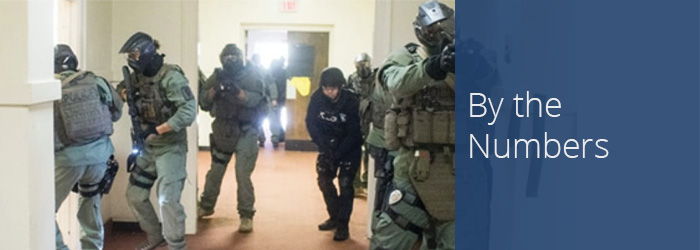
73 improvised explosives security trainings: The FEMA Center for Domestic Preparedness and the DHS Office for Bombing Prevention delivered 73 courses on improvised explosives security, training 1,763 emergency response professionals on bombing prevention and response actions for improvised explosive devices.
268 intelligence products: FBI produced 268 intelligence products for special events (e.g., high-profile meetings; dignitary visits), including five National Special Security Events and two International Special Security Events.
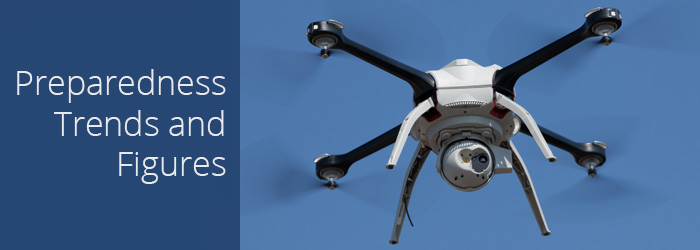
Increasing Use of Small Unmanned Aircraft Systems: In 2015, the Federal Aviation Administration (FAA) released nationwide data on the rising number of incidents involving small unmanned aircraft systems, which highlight the preparedness challenges these systems present to securing airspace and physical infrastructure. From November 2014 to August 2015, FAA received more than 700 reports from pilots and air-traffic personnel of unmanned aircraft system sightings. The number increased from 20 reports of sightings in November 2014 to more than 100 per month between May and August 2015. Moreover, the majority of sightings occurred above FAA’s recommended 400-foot ceiling for small unmanned aircraft systems, increasing the risk of collisions with other aircraft flying at low altitudes.

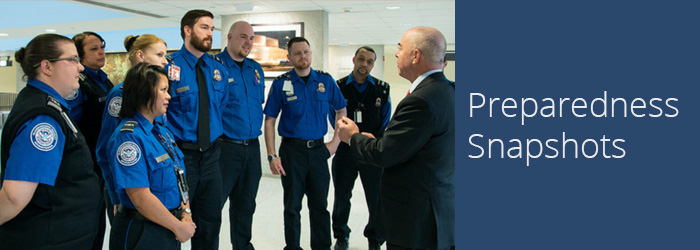
University of Maryland: Researchers from the University of Maryland’s National Consortium for the Study of Terrorism and Responses to Terrorism, with support from the DHS Science and Technology Directorate and the National Institute of Justice, released preliminary findings from a database (named Profiles of Individual Radicalization in the United States) to help policymakers and law enforcement personnel understand common indicators of domestic violent extremist radicalization. The project identifies the key indicators of radicalization for over 1,500 U.S.-based individuals. Analysis of this data will help researchers understand pathways to radicalization.
Erie Community College: In partnership with the Transportation Security Administration (TSA), Erie Community College in New York State designed a homeland security training program specifically for TSA officers. The online program trains officers in intelligence analysis and counterterrorism to enhance the detection of threats to airport security. In 2015, 150 TSA officers from 38 different airports completed the training program. This is one of more than 30 partnerships that TSA has established with institutions of higher education to provide classes at all federalized airports, as well as distance learning.
U.S. Department of State and United Arab Emirates: The U.S. Department of State and the United Arab Emirates launched the Sawab Center in July 2015, which is the first multinational online messaging and engagement program designed to counter terrorist propaganda, such as messaging that is used to recruit foreign fighters, fundraise for illicit activities, and intimidate and terrorize local populations.
Protection

The Protection mission area is focused on actions to safeguard the Nation's people, critical assets, and networks against acts of terrorism and manmade or natural disasters in a manner that allows American interests, aspirations, and way of life to thrive.
Cyber breaches that target personal information demonstrate the importance of cybersecurity information sharing between the public and private sectors, particularly in increasingly targeted industries, such as healthcare.
Several high-profile breaches of Federal computer networks in 2015 illustrate infrastructure and workforce obstacles to securing government systems.
While states are focusing more attention on cybersecurity by expanding the responsibility of state Chief Information Security Officers and investing a larger portion of their Federal preparedness grants in improving cybersecurity planning and equipment, cybersecurity capabilities remain at risk of decline.
Major security lapses in its passenger screening methods have led TSA to end the Managed Inclusion 2 program and take steps to address the problem by increasing emphasis on other risk-based initiatives, such as extending the TSA Pre✓® program.
Federal departments and agencies have made progress in improving chemical facility safety and security, as well as educating chemical facility operators and surrounding communities about their rights, obligations, and existing safeguard requirements.
A disruption in the biomedical supply chain has impeded laboratory testing and biomedical research, jeopardizing biosurveillance efforts and processes for developing medical countermeasures.
Widespread adoption of chip-enabled payment cards has bolstered national resilience to debit and credit card fraud, crimes that have complicated interdicting and disrupting terrorist financing.
Federal, state, and local agencies are expanding international and domestic partnerships to advance planning and coordination efforts for countering violent extremism.
To improve victim survivability in active-shooter incidents, Federal efforts are focusing on improving response coordination and empowering bystanders to engage in life-saving actions.
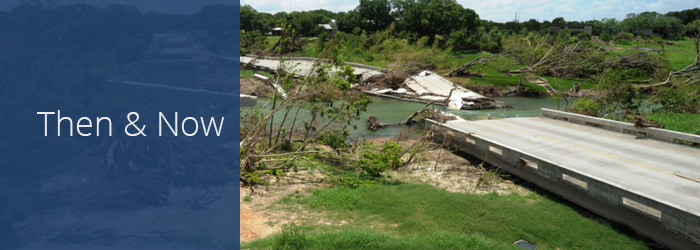
Personal Identity Verification Cards: The 2012 National Preparedness Report discussed rapid progress in issuing personal identity verification cards to Federal employees and contractors, but slower progress in implementing these cards to access Federal facilities and networks. Various efforts since then, including a Cyber Sprint in 2015, have increased card implementation tenfold, from 7 percent at the end of fiscal year 2011 to more than 76 percent at the end of fiscal year 2015.
RadNet: The 2012 National Preparedness Report discussed nationwide surveillance systems for biological and radiological agents, including RadNet, a national network of monitoring stations that regularly collects samples to analyze for radioactivity. Over time, the U.S. Environmental Protection Agency (EPA) has added new stations, as well as upgraded existing ones. RadNet now includes 135 stationary monitors around the country and 40 portable stations for placement in an emergency.
Regional Resiliency Assessment Program: This program performs assessments of critical infrastructure systems within a particular geographic region. By the end of 2012, the DHS National Protection and Programs Directorate (NPPD) had partnered with stakeholders to complete 27 assessments, which identified critical infrastructure interdependencies, cascading effects, and capability gaps. Since then, DHS has explored ways to adapt the assessment process to address emerging issues, such as climate change, cybersecurity, and electromagnetic-pulse preparedness.

1,700 trainees: DHS NPPD provided 1,700 participants from commercial facilities in various critical infrastructure sectors with training on the threat from violent extremism, including courses on “Understanding Violent Extremism and Radicalization” and “Enhancing Security for Violent Extremism.”
2,653 firearms interdicted: In 2015, TSA screened more than 700 million passengers at airports nationwide, interdicting 2,653 firearms.
120 participants: The National Association of State Energy Officials, in partnership with the U.S. Department of Energy and the National Conference of State Legislatures, delivered a State Energy Risk Assessment workshop to 120 state and local energy and emergency-management officials.
500 partners: In fiscal year 2015, more than 500 Federal, state, and local partners—including representatives from environmental, law enforcement, public health, and transportation agencies; fire departments; emergency medical services; national laboratories; and National Guard units—participated in BioWatch drills and exercises.
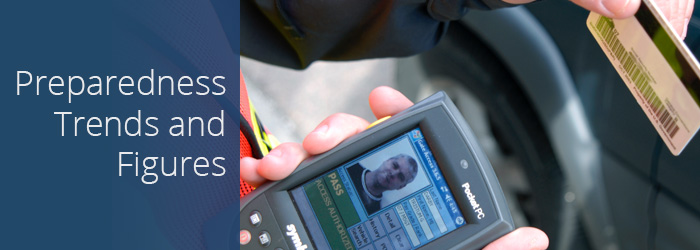
Access Control and Identity Verification in Federal Agencies: In 2015, a Cyber Sprint initiated by the White House resulted in the single largest increase in the use of secure access to government systems since the adoption of smartcards (i.e., identity badges embedded with computer chips) was mandated in 2004. Ensuing efforts by Chief Information Officers led to an increase in smartcard use in civilian agencies, from 41 percent at the end of 2014 to 81 percent as of November 2015. Improving implementation of smartcards for controlling and validating access to Federal facilities and systems was noted as an area for improvement in the 2015 National Preparedness Report, further demonstrating the effectiveness of the Cyber Sprint initiative.


National Crime Information System: Ten tribes began participating in a trial of the U.S. Department of Justice's (DOJ) National Crime Information system, which allows them to access and exchange data on crime with Federal and state governments. This pilot project provides tribal law enforcement agencies with direct access to Federal, state, and local criminal records for the first time, thereby enhancing community resilience and the safety of tribal law enforcement.
National Cyber Security Awareness Month: In October 2015, DHS sponsored the 12th annual National Cyber Security Awareness Month. National Cyber Security Awareness Month—which the White House, 48 states, and 35 local governments have recognized through signed proclamations—engages the public and private sector through events and initiatives to raise cybersecurity awareness and increase the Nation’s resilience to cyber threats. More than 140 events took place across the country, which is 16 percent more than the previous year.
University of Michigan: In October 2015, the University of Michigan and Google launched Censys, a cybersecurity tool that identifies security concerns by tracking networked devices and assessing their level of security. The project has resulted in the enhanced security of more than 100,000 industrial control systems.
Mitigation

The Mitigation mission area is focused on reducing loss of life and property by lessening the impact of disasters through increasing risk awareness and leveraging mitigation products, services, and assets.
The Nation has become progressively more vulnerable to dam failures and continues to face challenges repairing and identifying structurally impaired dams whose failure could severely affect nearby communities.
The effects of climate change are a growing concern, and members of the public and private sectors are increasingly taking steps to prepare for the impacts.
The energy, transportation, and health sectors have taken steps to generate ideas, tools, and metrics for increasing critical infrastructure resilience, but reducing vulnerabilities remains a challenge, given increasing impacts from climate change and limited resources available for maintenance.
With evidence suggesting that fewer Americans developed a household emergency plan in 2015 than in 2014, Federal agencies and community partners attempted to increase the visibility of their messages by targeting individual communities and tying preparedness messages to notable events.
While new research stemming from recent events demonstrates the value of mitigation, the Federal Government has not developed a strategic approach for investing in mitigation activities.
Federal agencies are successfully advocating updates to the most recent editions of building standards to help communities strengthen structural disaster resilience. While many jurisdictions continue to adopt stronger local building codes, a few states have passed legislation to weaken building codes.
Studies and real-world examples have demonstrated resilience benefits from investments in natural infrastructure, and the Federal Government is encouraging broader adoption of these techniques by providing new planning tools and resources.
New research highlights the risk of longer and more intense droughts in the future. Federal agencies have improved interagency coordination for collaborating with states, tribes, and communities to build drought resilience.
Recognizing that wildland fires increase the likelihood of flooding, the Federal Government is promoting flood mitigation measures in areas recently affected by wildland fires.
In response to challenges exposed during the Hurricane Sandy claims process, the National Flood Insurance Program implemented program changes and pilot processes to improve customer experience.

Mitigation Plans: As of December 31, 2015, 22,706 communities have mitigation plans that are FEMA-approved (or approvable, pending adoption), up from less than 18,000 in 2010. The percentage of the Nation’s population covered by planned mitigation strategies has increased from 69 percent in 2011 to 83 percent in 2015.
Community Rating System: This program offers flood insurance discounts to policyholders in exchange for their community enacting flood-control and floodplain management policies that exceed the National Flood Insurance Program’s minimum requirements. In 2012, there were a total of 1,100 participating communities—that has since grown to 1,368 in 2015.
StormReady and TsunamiReady: The number of communities that have voluntarily committed to advanced mitigation efforts under the National Weather Service’s StormReady and TsunamiReady programs has increased from 1,950 in 2012 to 2,424 as of February 2016.

300,000 information sheets: The National Oceanic and Atmospheric Administration (NOAA) distributed 300,000 NOAA Extreme Weather Information Sheets. These waterproof, “one-stop” reference guides contain phone numbers and web resources that residents can use during life-threatening weather emergencies.
$21 million in losses avoided: Research suggests that the $8 million that NOAA and the Nature Conservancy invested in the Fisher Slough Marsh restoration project in Washington State will save the community up to $21 million over the next 50 years and reduce flooding on as many as 600 nearby acres.
23 states rehabilitating dams: The U.S. Department of Agriculture (USDA) provided $73 million in funding for about 150 dam rehabilitation and assessment projects in 23 states in order to ensure that the dams are protecting individuals from floods and providing essential water supplies in areas affected by drought.

Increasing State Planning for Climate Change: A growing number of states are considering the risks associated with climate change in their planning efforts. For example, climate adaptation plans lay out specific actions that states will undertake to reduce their vulnerability to climate change. According to data from the Georgetown Climate Center, the number of states that have chosen to adopt statewide climate adaptation plans increased steadily from only two in 2008 to 14 in 2013. Although no new states have finalized climate adaptation plans since 2013, nine states have plans currently under development. In addition, the number of states and territories that reported considering climate change when developing their Threat and Hazard Identification and Risk Assessment rose to 38 in 2015 from 28 the previous year.


Minneapolis and Hennepin County, Minnesota: Minneapolis and Hennepin County, Minnesota created a calculated priority rating index for their Threat and Hazard Identification and Risk Assessment. The index measures the probability and magnitude of their threats and hazards, helping them to identify their capabilities of greatest need and to effectively prioritize resilience investments.
The University of Alaska: University of Alaska Fairbanks launched The Modern Blanket Toss, a program where students from local high schools developed and operated unmanned aircraft systems that took aerial photographs of hard-to-access areas in order to help local community leaders evaluate future flood risks.
NOAA: NOAA and the University of Nebraska–Lincoln jointly created the new Drought Risk Management Research Center, which focuses on improving drought monitoring and risk management for Federal, state, tribal, and local partners.
Community Resilience Center of Excellence: In 2015, the National Institute of Standards and Technology entered into a cooperative agreement with a team of 11 universities, led by Colorado State University, to establish the Community Resilience Center of Excellence. The focus of the Center is to develop models and tools to assess the resilience of communities and support decisions for investment in local infrastructure that reduce the impact and burden of natural and manmade disasters.
HHS: HHS launched the HHS emPOWER Map, which is a public, interactive map that uses Federal health data and NOAA severe-weather services to help Federal, state, local, and community partners anticipate, plan for, and respond to the needs of electricity-dependent individuals, whose lives may be threatened or lost by a severe weather–induced power outage.
Response

The Response mission area is focused on ensuring that the Nation is able to respond effectively to all types of incidents, including those of catastrophic proportion that require marshalling the capabilities of the entire Nation.
The severe 2015 wildland fire season strained fire suppression resources, and volunteers and international partners supplemented the response of states and the Federal Government.
Across the Nation, government agencies and industry partners have taken steps to secure the movement of shale crude oil by rail and prepare communities to respond to rail incidents involving crude oil. However, challenges remain in implementing railcar safety standards, training first responders, and sharing information between the rail industry and state and local communities.
Federal agencies and state and local health organizations have taken actions to enhance the Nation’s response capabilities following challenges encountered during the 2014–2015 Ebola virus disease outbreak.
The 2015 avian influenza outbreak revealed waste management and biosecurity gaps in the Nation’s ability to respond to animal disease outbreaks.
The Nation has made progress in understanding and addressing the needs of children in emergency response planning.
Federal, state, and local agencies used technology and new methods to enhance the effectiveness of training and exercises for responders and train traditionally under-engaged communities.

Chemical, Biological, Radiological, Nuclear Response Enterprise: The 2012 National Preparedness Report discussed a growing number of assets under the U.S. Department of Defense's (DoD) Chemical, Biological, Radiological, Nuclear Response Enterprise. Since then, the enterprise has achieved full operational capability. DoD has focused on ensuring effective integration of these assets with Federal, state, and local organizations through guidance and exercises such as VIGILANT GUARD and VIBRANT RESPONSE.
Integrated Public Alert and Warning System (IPAWS): In 2011, commercial television and radio broadcast stations and cable television systems participating in IPAWS were able to deliver public information and warnings to 84 percent of the U.S. population. By 2015, this grew to more than 90 percent.
Distribution of Medical Countermeasures: The 2012 National Preparedness Report discussed how the Centers for Disease Control and Prevention (CDC) conducted annual technical assistance reviews to assess state and local plans to receive and distribute medical assets from CDC’s Strategic National Stockpile. While successfully used for a decade to assess planning, the assessment did not accurately reflect the ability of these jurisdictions to implement and execute their plans. As a result, CDC implemented a new review process designed to also assess operational capabilities in July 2015.

465,869 hours of disaster response assistance: Members of FEMA Corps teams provided 465,869 hours of disaster response assistance across 22 states and Guam.
5,000 faith leaders and government officials: As of December 2015, the DHS Center for Faith-based and Neighborhood Partnerships conducted 10 regional trainings and more than 30 in-person and virtual presentations to educate more than 5,000 faith leaders and government personnel on the Guide for Developing High-Quality Emergency Operations Plans for Houses of Worship.
2,664 Community Emergency Response Team programs: FEMA registered 181 new Community Emergency Response Team programs, which train community members in basic disaster response skills and organize them into teams of volunteers, raising the total number of programs to 2,664.
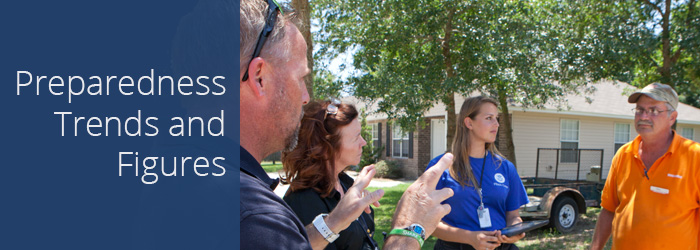
Building National Capacity for Inclusive Emergency Management: To support the equal physical access, effective communication access, and programmatic access of individuals with disabilities and others with access and functional needs, the FEMA Office of Disability Integration and Coordination established a cadre of disability integration specialists, who are providing guidance and technical assistance to ensure that disaster response and recovery efforts are fully inclusive. Between 2012 and 2015, FEMA deployments of disability integration advisors supported disaster responses, exercises, training, mitigation activities, and long-term recovery efforts. During this period, these deployments increased by 260 percent—from 30 deployments in 2012, to 108 in 2015. The cadre includes full-time Disability Integration Advisors on each of FEMA’s National Incident Management Assistance Teams, as well as a full-time Regional Disability Integration Specialist in each of the 10 FEMA Regions.
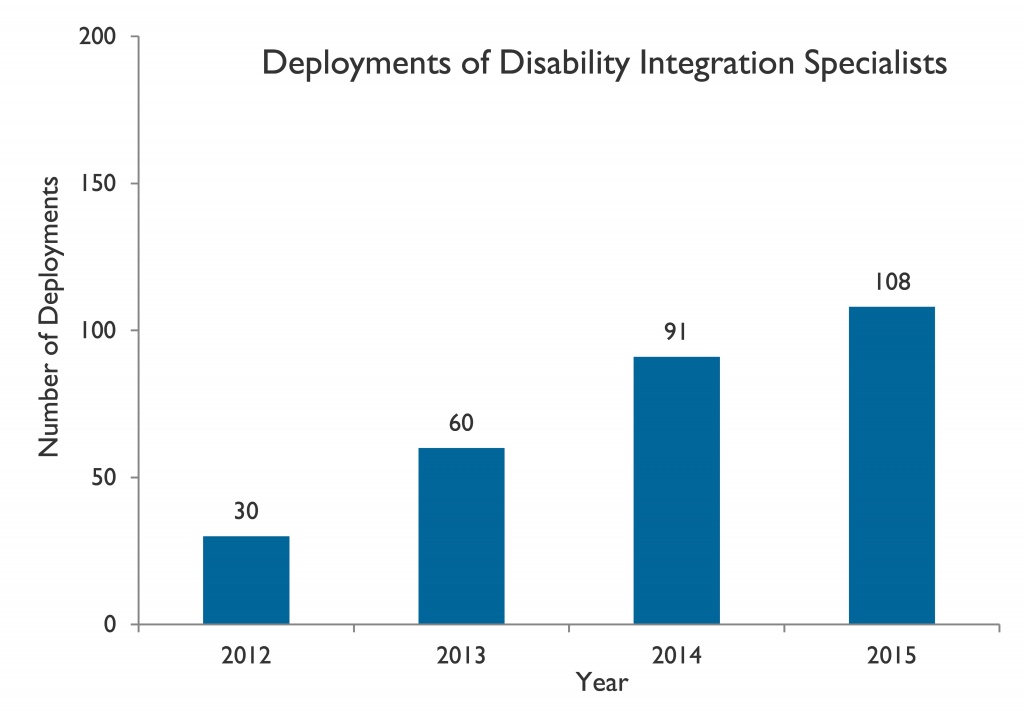
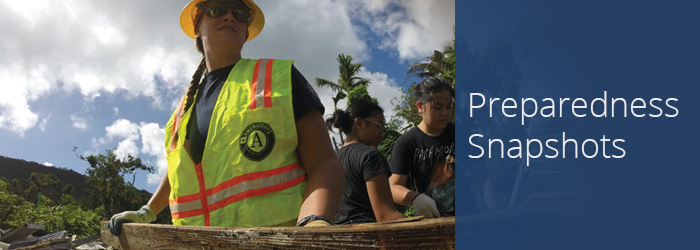
Saipan: In Saipan, Typhoon Soudelor rendered 48 percent of the island’s power grid inoperable, leaving residents without power and with limited access to potable water. In response to the water shortage, DoD distributed more than 300,000 gallons of water. United 4 Saipan, a grassroots volunteer group, provided water and food to survivors and continues to organize debris removal events. Ten AmeriCorps Disaster Response Team members and a Corporation for National and Community Service member worked with voluntary organizations active in disasters from Saipan to establish a volunteer coordination structure and train local volunteers. Thirty personnel from the Guam Power Authority supported power restoration efforts on Saipan, and the California Utilities Emergency Association and Pacific Power Association worked directly with the Commonwealth Utilities Corporation to contract materials and supplies.
Washington and California: A member of the Muckleshoot Teen Community Emergency Response Team from the Muckleshoot Indian Reservation in Washington State and native youth from Sherman Indian High School—a Bureau of Indian Education school in Riverside, California—presented projects they have implemented in their communities at the National Congress of American Indians annual conference. Projects included developing a video on active-shooter preparedness, creating a poster in the languages of Native Americans living in California to alert native citizens of fault lines in the state, and making emergency backpacks for community elders.
National Voluntary Organizations Active in Disasters: In 2015, the National Voluntary Organizations Active in Disasters launched VOADnet, an online, interactive platform for member organizations. This platform enables members to communicate and coordinate requests for and sharing of needed resources during disasters, as well as share best practices and lessons learned. Members used the website for disasters such as the South Carolina floods, western wildland fires, and the Pacific typhoons.
Recovery

The Recovery mission area is focused on a timely restoration, strengthening, and revitalization of the infrastructure; housing; a sustainable economy; and the health, social, cultural, historic, and environmental fabric of communities affected by a catastrophic incident.
To address persistent gaps in the recovery capabilities of states and territories, Federal agencies have developed new guidance, courses, and trainings to assist all levels of government.
New research and recent Federal initiatives encourage decision-makers to incorporate health considerations into all aspects of disaster recovery planning.
The Federal Government is expanding health information-sharing systems to enhance pre-disaster recovery planning and post-disaster research capabilities for health and social services.
Challenges hindering post-disaster economic recovery include inadequate communication with the business community and a lack of familiarity with Federal assistance programs. Public- and private-sector partners have promoted economic resilience and business continuity planning to strengthen recovery efforts.
Damage to the ecosystems of communities with local economies dependent on natural resources can amplify disaster impacts and prolong recovery.
The condition and age of the Nation’s infrastructure systems remain high-priority issues, and public- and private-sector partners are making incremental improvements to the resiliency of transportation and other infrastructure systems through collaborative investments.
The Nation has made progress in meeting the disaster housing needs of low-income families and individuals with access and functional needs, but persistent housing challenges remain at all levels of government.

Disaster Assistance to Recovery Core Capabilities: From fiscal year 2006 to fiscal year 2010, less than one percent of DHS non-disaster preparedness assistance supported Recovery core capabilities. In fiscal year 2014 (the latest year for which data were available), this number remained low, totaling roughly one percent of total non-disaster preparedness grants.
Behavioral Health in Recovery: Since 2012, the Federal Government has increasingly incorporated behavioral health considerations into response and recovery efforts through implementation of the HHS Disaster Behavioral Health Concept of Operations, and the deployment of HHS mental health teams and new psychological first-aid training for first responders.
American Public Power Association: Since 2012, the American Public Power Association has expanded its mutual aid program, including the establishment and growth of a Mutual Aid Working Group for public power utilities to share best practices related to disaster response, recovery, and mitigation.

11,500 U.S. Small Business Administration (SBA) Disaster Assistance loans: In fiscal year 2015, SBA provided 11,500 Disaster Assistance loans totaling $371.7 million to help businesses, homeowners, and renters repair and replace physical losses, and to assist businesses with post-disaster operating expenses.
13 states: In February 2015, USDA invested $84 million through its Emergency Watershed Protection Program to fund more than 150 recovery projects in 13 states that had been affected by floods, fires, windstorms, or other natural disasters.
$5.4 billion: As of May 2015, Federal agencies have awarded $5.4 billion to Mississippi to repair or restructure approximately 40,000 housing units, restore more than 200 public facilities, and create almost 6,000 new jobs.
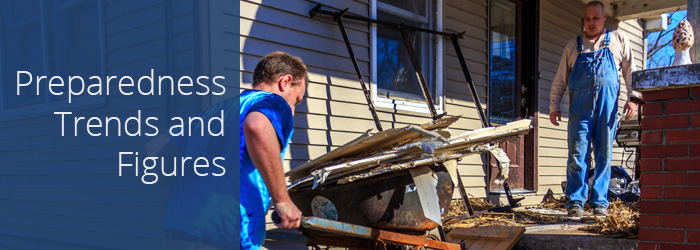
Mixed Trends in Exercising Recovery Capabilities: Over the past three years, the FEMA National Exercise Program has supported an increasing number of exercises focused on Recovery core capabilities—from nine exercises in 2013 to 23 in 2015. Despite this increase, State Preparedness Report submissions indicate mixed progress in exercise ratings for Recovery core capabilities. Excluding Planning, Public Information and Warning, and Operational Coordination (which are common to all mission areas), only one of the five remaining Recovery core capabilities demonstrated a positive increase in proficiency ratings from 2012 to 2015. Specifically, the rating increase in exercise proficiency for Infrastructure Systems (10 percent) was more than two times larger than the average across all core capabilities (four percent). In contrast, Natural and Cultural Resources, Housing, and Economic Recovery all experienced steady decreases, and Health and Social Services experienced minimal change in exercise ratings from 2012 to 2015.
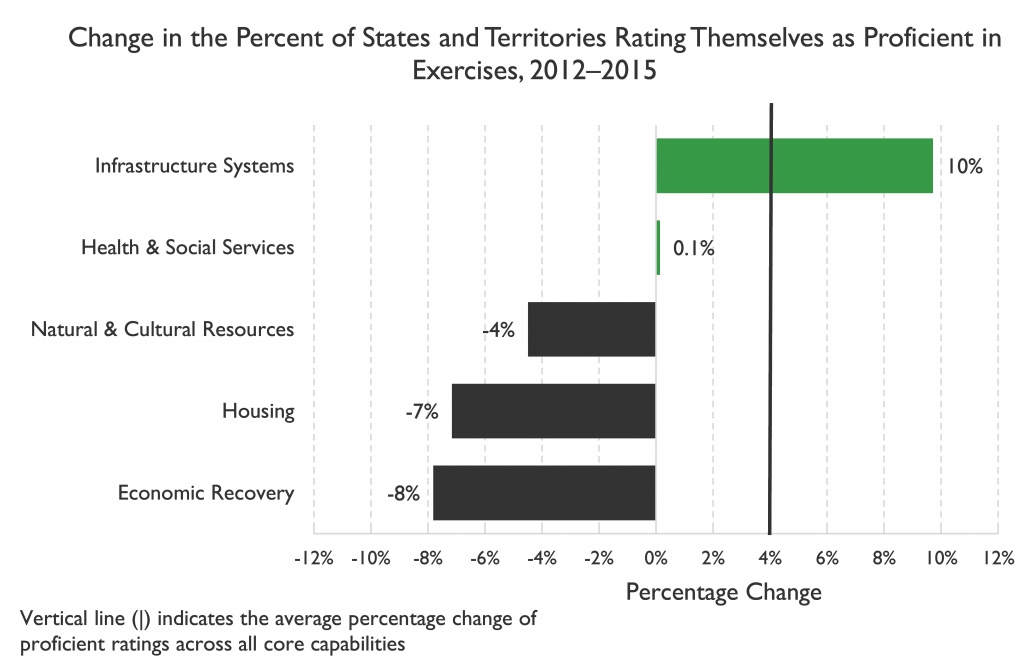

Faith-based Organizations: Episcopal Relief and Development, a national faith-based volunteer organization supporting disaster response and recovery, launched a nationwide asset-mapping platform in 2015 that volunteers can use during disasters to coordinate and identify available relief and recovery resources. This platform will help assess a disaster’s impact and coordinate the organization’s active assets in affected areas.
University of Oklahoma: In 2015, the University of Oklahoma established the Resilience Development Institute to equip leaders and professionals with the latest tools for and knowledge of resilience, risk reduction, and disaster recovery. The training consists of three, one week–long sessions that include presentations, interactive exercises, and case studies addressing pre- and post-disaster recovery planning.
HHS, Health Researchers, and the Centers for Medicare and Medicaid Services: In 2015, researchers concluded 31 research projects funded by HHS to support post–Hurricane Sandy recovery efforts. These projects generated best practices and tools to enhance future recovery efforts, including insights into the provision of mental health services and tools to enhance coordination between local health departments and nongovernmental organizations. In addition, ASPR and the Centers for Medicare and Medicaid Services published results of a research study that followed treatment patterns and outcomes of 13,000 New York City and New Jersey dialysis-dependent patients around the time of Hurricane Sandy. The study identified mitigation measures that both protected patients’ health (e.g., reduced deaths) and minimized stress on the healthcare system before, during, and after the hurricane.
Conclusion

Throughout 2015, the Nation continued to strengthen its national preparedness. As the 2016 National Preparedness Report shows, all five mission areas (Prevention, Protection, Mitigation, Response, and Recovery) saw progress, and the Nation continued to develop the capacities needed to address the hazards and threats the Nation faces. In some areas, however, persistent challenges remain and new preparedness challenges emerged.
Looking across all five mission areas, the 2016 National Preparedness Report identifies three capabilities to sustain. For these capabilities—Planning; Public Health, Healthcare, and Emergency Medical Services; and Risk and Disaster Resilience Assessment—the Nation has developed acceptable levels of performance, but will require sustained effort to maintain proficiency and meet emerging challenges.
This National Preparedness Report highlights six core capabilities as national areas for improvement: Cybersecurity; Economic Recovery; Housing; Infrastructure Systems; Natural and Cultural Resources; and Supply Chain Integrity and Security. The National Preparedness Report has identified Cybersecurity, Housing, and Infrastructure Systems as areas for improvement since 2012, but continuing challenges highlight the difficult task of improving these areas.
As the 2016 National Preparedness Report demonstrates, individuals and communities, private and nonprofit sectors, faith-based organizations, and all levels of governments continued to build, sustain, and deliver the core capabilities needed to achieve the National Preparedness Goal of a secure and resilient Nation. While new threats and challenges will continue to appear, the Nation will continue to adapt to address them.
Grant Case Studies

Federal homeland security grants play an important role in helping state, local, tribal, and territorial governments build and sustain capabilities, and implement the National Preparedness System. In 2015, FEMA partnered with stakeholders in California, Minnesota, Michigan, and Philadelphia to illustrate the impact of Federal grants on preparedness. FEMA chose these locations to highlight grant-funded projects focused on Housing and Cybersecurity, which have been national areas for improvement in five successive National Preparedness Reports, and on other innovative projects that may be of interest to readers.
FEMA also completed two case studies focused on grant projects that positively affected the 2014 response to Ebola virus disease. The first explored how the National Domestic Preparedness Consortium, which receives annual grant funding from Congress, rapidly developed and delivered a training course for emergency responders on preparing for Ebola virus disease. The second was a joint effort with HHS and New York City to document how preparedness investments over time enabled the city to quickly implement an effective response to the disease.
View 2015 Case Studies here: www.fema.gov/grant-case-studies
Read the Full Report
Below are links to the full National Preparedness Report:
- 2016 National Preparedness Report
- 2016 National Preparedness Report Executive Summary
- Prevention Overview
- Protection Overview
- Mitigation Overview
- Response Overview
- Recovery Overview
Contact Us
If you have questions about the report, please contact us at NPR@fema.dhs.gov.
